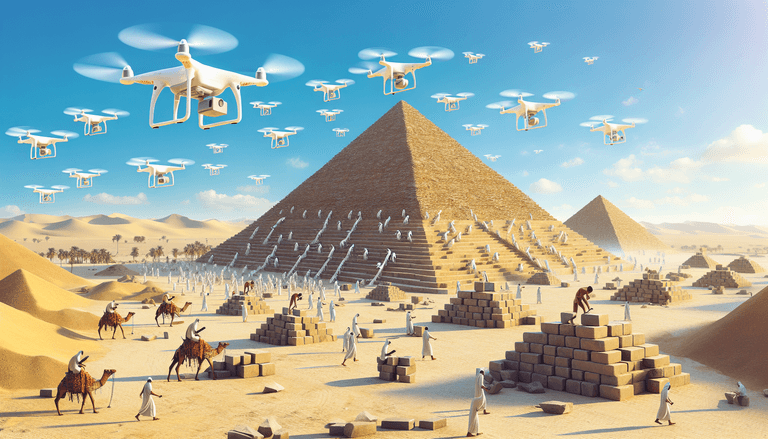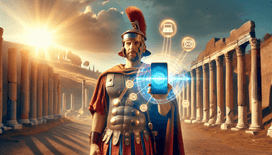Picture this: it's a blisteringly hot day in Ancient Egypt, around 2,500 BC. Pharaoh Khufu struts around Giza, blissfully unaware of the sweat-filled labour his project has demanded. The Great Pyramid is under construction. Traditionally, thousands of labourers would have lugged enormous limestone blocks up precarious ramps, all while being whipped into shape by overseers as understanding as stone. But what if, in an alternate reality more tantalising than Cleopatra's kohl-lined gaze, they had access to modern construction drones?
From sandstone nightmares to drone dreams
Imagine the efficiency if those colossal blocks were being hoisted and gently coaxed into place by a fleet of buzzing, tireless drones. Gone would be the days of workers straining like a rampaging hippopotamus up a narrow Nile tributary. Instead, the pyramid construction site would resemble a well-coordinated sky-ballet, an airborne ensemble performing under Ra's watchful eye.
The pyramids, once the triumph of human determination over a desert's cruelty, would now be a glorious testament to the wonders of rotor engineering. With drones at their disposal, the Egyptians could've had more time for leisure activities, like inventing more hieroglyphs or trying to figure out why cats were suddenly ruling their lives.
Why drones would work like Egyptian magic
But you might ask, "Oh great scribe of alternate histories, why drones and not, say, a giant pulley system operated by very large crocodiles?" To this, I say: have you ever tried getting crocodiles to listen? No, dear reader, there are several reasons why drones are the tech of choice.
- Precision: Not even the most skilled of pyramid builders could match a drone's GPS-coordinated accuracy. Those blocks would be as precisely placed as the stars in an astrologer's chart.
- Speed: Even the fastest chariots can’t compare to the swift manoeuvres of our modern drones. Efficiency is key when you’re balancing boulders.
- Labour-saving: Fewer herniated pharaohs and blistered hands. The ancient Egyptian greeting "May your back carry the weight of a thousand stones" could've been replaced with "May your batteries never deplete."
Pyramids: The new 7-gigabyte wonder
With drones at the helm (or should I say controller?), construction times could've been slashed more effectively than an Anubis-themed slasher flick. Where years stretched into multiple decades, complex pyramids might spring up in a matter of mere years. The view from Khufu’s living quarters would transform faster than you can say "Tutankhamen’s tomb salon."
Imagine the ripple effect on history. The reduced construction time would mean more pyramids. The Giza plateau could be brimming, bustling with monumental structures like it was hosting the ancient Egyptian Pyramid Expo 2K23 BC.
Caution: No sand in your drone's rotors
Of course, we mustn't get too swept up, like a camel in a sandstorm, in the fantasy. Drones would face challenges. Imagine the stress of maintaining a fleet amidst desert storms, heat, and the peculiar curiosity of any feline that happened by. After all, nothing piques a kitten's interest quite like a dangly, whirring object.
The final flight
To conclude this high-flying journey through the sands of time, we must realise that while history has its wonders, imagining the application of modern technology to ancient feats gives us a new perspective on human ingenuity. The building of the Great Pyramid is a testament to mankind's resourcefulness and determination. And just as a drone's propellers spin tirelessly, so too does the wheel of history, forever curiouser and curiouser.
So next time you see a drone hovering overhead, just remember: there was once a pyramid that might have stood the test of time and tech. Oh, what a site to be seen, or rather, what a sight they would've been!







